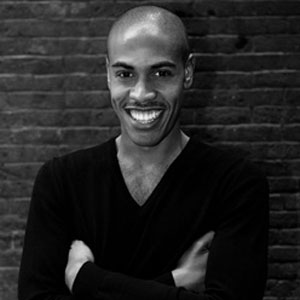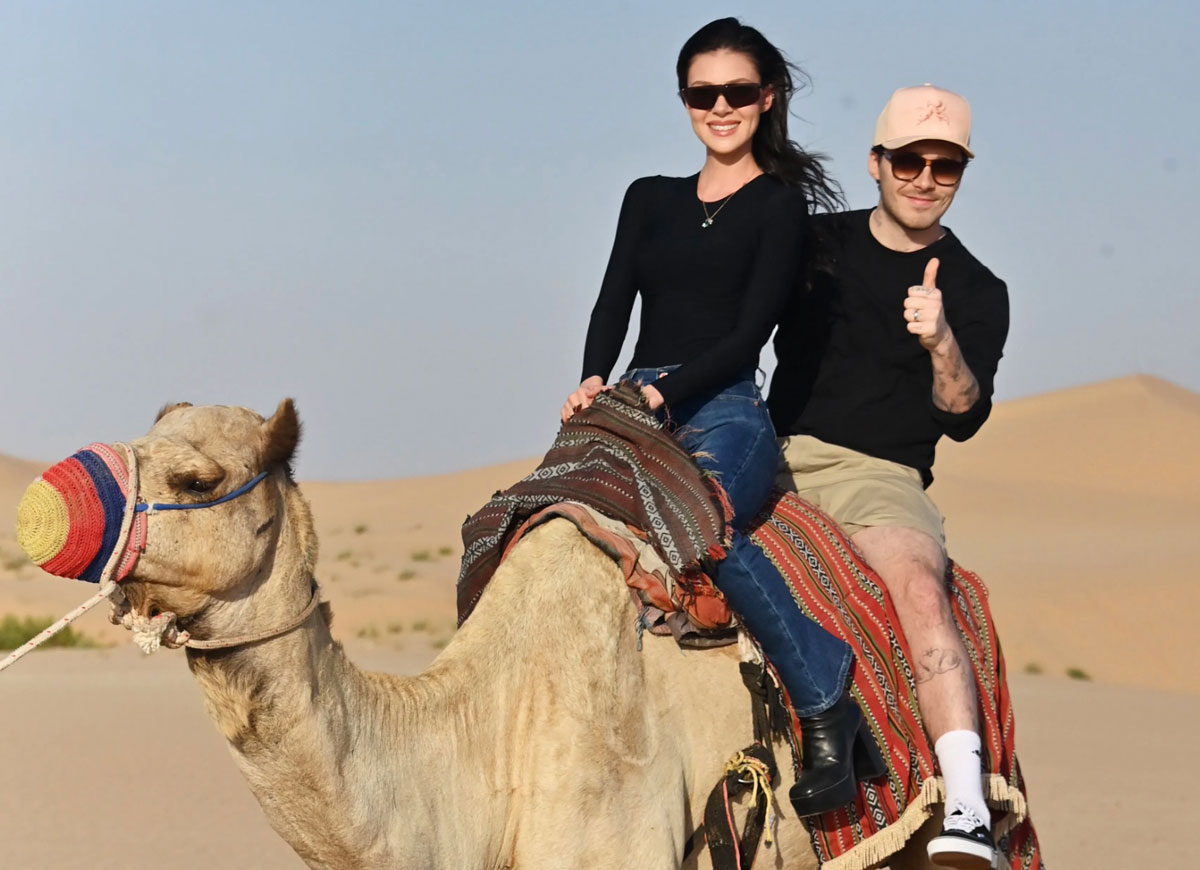Charles Harbison Interview On His Line Harbison, New York Fashion Week, His Aesthetic
Charles Harbison, designer of the new womenswear line Harbison, developed an interest in fashion at a young age from watching and spending time with his mother. "After coming home [from work], she would transform into this more confident, elegant representation of herself," Harbison told Uinterview exclusively. "I know now that that's what I'm referencing and that's what I want to continue to do for women — offer them the tools so that they can aesthetically represent themselves to the world in a way that gives them confidence and ease of mind."
Harbison's design principles were largely guided by the Bauhaus modernist movement during his formative years studying design. "I was taught to understand portion and scale, balance and structure," said Harbison. "This movement out of Germany that was so disciplined in a beautiful sort of way. So I tried to apply those tenants to the clothes."
In his designs, Harbison strives to shadow the inherent contradictions that exist within women. "I love to give her access to those parts of herself where she can be fully feminine and love the soft, nurturing, fragile aspects of herself," Harbison told Uinterview exclusively. "But at the same time, she gets to incorporate the aspects of her that are strong, that can be dominating, that can be challenging and that's that hard and soft that I love to represent thematically. And then the baseline is just giving her beautiful clothes that she can live in."
In September, Harbison showed at New York Fashion Week and he was greeted with resounding praise by the fashion press. "I still haven't completed my first year so business is moving at a really amazing pace but slowly," said Harbison. "Each of these affirming moments, every moment is like, 'Ok, there's a market. There's a woman that exists that enjoys what I'm doing and that there is a place for me, there's a niche. So Charles, keep going!'"
I grew up as a working class boy and my mom was a factory worker. She would come home and she would be a distinctly different person, going to work and coming home from work. After coming home, she would transform into this more confident, elegant representation of herself in the evenings and on the weekends. Our special time together largely was going to the mall, where it was her and her son. My younger brother is seven years younger than me, so I had all this time where it was just me and Mom. I can remember her holding my hand and going through the mall and little boys suits with shorts. I just came to love this time with her, where she was just more confident and less stressed and her carriage was so different and I took note of that. And I know now that that's what I'm referencing and that's what I want to continue to do for women - offer them the tools so that they can aesthetically represent themselves to the world in a way that gives them confidence and ease of mind. So that's how it kind of started. I just thought, 'Mom's awesome.' She was laced in color and it was the 80s, so it was a multicolored jacket, a pump and a clutch that all matched.
I entered undergrad as an Architecture major. During that first year, there was this fundamentals class that all design students had to be a part of and we touched different mediums. I remember that once I started working with fabric, I just felt different. And I'd always loved painting and I thought that might be a minor of mine, but then I learned that textile arts and fiber arts was a whole discipline in and of itself. So after discovering that, I left architecture and went into fabric and fiber arts and painting. I also picked up a Textile Science degree to market myself. It wasn't until the end of my undergraduate education, when I did some independent studio work in fashion, that I applied that love of textiles to garments. Everything just kind of came full circle from there.
My art training and education are largely based in Bauhaus because my school professor loved the modernist movement and it resonated with me. I was taught to understand portion and scale, balance and structure. I think it's not only an incorporation of that architecturally leaning mind that I had in the beginning but it's also what the Bauhaus was all about. This movement out of Germany that was so disciplined in a beautiful sort of way. So I tried to apply those tenants to the clothes - to create a product that actually works and in thinking about portion, scale and balance in a disciplined approach to sportswear design.
I think that, intrinsically, all of us embody masculine and feminine energy. Then, over time, we fall into our gender roles. Women specifically, because of sexism in our society, they're largely marginalized and they don't get to express as freely that confident place, that place of directing others, and really being bold, and having a vision the same way that men do. So I love to give her access to those parts of herself where she can be fully feminine and love the soft, nurturing, fragile aspects of herself. But at the same time, she gets to incorporate the aspects of her that are strong, that can be dominating, that can be challenging and that's that hard and soft that I love to represent thematically. And then the baseline is just giving her beautiful clothes that she can live in. So it's about the beauty but it's also about the practicality of her life, so it's that yin and yang. It's also taking softer fabrics and doing more structured garments, so there's that hard and soft. I think you really get something fresh and new when you apply two seemingly conflicting forces and figure out a way to make them come together nicely. All eyes are on that woman and that's my woman. She loves being a woman but at the same time she doesn't want to compromise the power that she has in her life and in the lives of others.
Basically, I just love to draw in the things of the moment that I found inspiring. I was listening to a lot of Aaliyah when designing the collection. She really embodied that masculine, feminine energy — fully feminine with the baggy pants. It's so visual. So there was that. And then I found this imagine of Katharine Hepburn in the middle of Montego Bay in a Rolls Royce in the 50s. She's amidst all these natives in Montego Bay, in a luxury vehicle. Very American preppy in the midst of native life. It felt largely not okay but it was interesting and super cool. And I love, once again, that seeming contradiction there. So that's how the African diaspora aspect and prep came together, by way of that image, and then you have Aaliyah. Then, lastly, was me looking at color. I love Yves Klein. He's a fabulous painter and he worked in a trifecta of that legendary Klein blue, magenta and gold. And so that was a color reference. So I brought all of those and fused them together.
I did not know. I did not know at all. It wasn't even something that I strategically walked into. I had been working since I came to the city. I went to Parsons and then left and was consistently working. I then came to a point where I thought, 'I think I have something interesting to say and I'm not sure if I am on the distinct trajectory to have the life that I want by way of continuing to work in these different houses.' Some people can, I just didn't feel like I was going in the direction that I wanted to go. So I left Billy Reid [fashion label], bought a bike, rode my bike, did yoga and visited my best friend in St. Croix. She has such a good life there and St. Croix was good to me. I have a Cruzan hook ring I got there that I wear every day to remind me. What it did for me was I saw her life there and I just kind of wanted to build a business in a new way. I came back and started working on Harbison at the end of 2012 and launched officially in February of this year with the first capsule collection. So it was just a response to where I was in my life. I feel like that's the most organic way to do it. There could have been far easier ways because I did walk into it largely not knowing a lot. I had never been at the helm of a team. I'd only been Senior Designer at these places and was answering to a Creative Director. And I don't come from a line of business owners or anything like that but I felt confident with the partnerships that I had in the city or that I could find them. And I just felt like, 'Hey, maybe I have something decent to say.'
This is a ring that my mother got me for graduation from high school. When I first got it, I was a 17, 18-years-old, and thought, 'What is this, Mom?' And I tucked it away and didn't think anything about it. And then I encountered it again several years ago and thought, 'This is the best thing that's ever been given to me in my life.' It's really unassuming, but it represents a lot of amazing trifectas in my life.
I was like, 'What? Wait, are they serious? Really?' I just asked a lot of questions. I still largely find it unbelievable. I was like, 'What? Me? Really? I don't understand.' I was terrified because you think 'What does this mean? Okay, we're going to keep going then.' I still haven't completed my first year so business is moving at a really amazing pace but slowly. Each of these affirming moments, every moment is like, 'Okay, there's a market. There's a woman that exists that enjoys what I'm doing and that there is a place for me, there's a niche. So Charles, keep going.' So that's largely how I respond to all of these things that happen.
The biggest surprise was when Virginia Smith walked in. She's the European Fashion Market and Accessories Director at Vogue. She previewed on the day of my presentation. The presentation started at 10 a.m., and she arrived around 9:30 a.m., and I just thought, 'You're here? And to see my clothes?' She's Anna's [Wintour] right hand. She and [Vogue Fashion News Director] Mark Holgate were amazing in the very beginning and offered me the exclusive on my debut fall collection that was in September's Vogue. So having Virginia walk in, once again, was like, 'Okay, we're doing this,' and she had such a great response to the collection and that was lovely. And also, [Fashion Director] Ken Downing from Neiman Marcus, was at my presentation, and [Fashion Reporter] Eric Wilson from the Times. I just felt like, 'Wow, you guys think that this is valid and legitimate,' and that makes me extremely excited.
It was immensely challenging. The logistics... it was a lot. It continues to be a lot but not in a bad way. But I think the thing that was almost the most challenging was the conversation with the models before the presentation where I preceded to break down. Running around and trying to get things together, we're shooting some of the clothes upstairs before we send the girls downstairs for the presentation, and I just wanted to cast some visions for the girls, to let them know the mood. They already largely knew, but I wanted to let them know that I appreciated that they were there, that it meant a lot that I get to show these garments that I love on them and that they get to embody this vision of what I have. It was just the fact that I was so connected to the moment, tired, overwhelmed, all of that, so I was talking to them and I just busted out of crying. And I heard one of my friends say, 'Pull it together, Charles,' and then I was just thinking, 'Ok, breathe.' Luckily, I broke down in front of the models instead of breaking down in front of the press, which would have been a whole other debacle.
I've kind of gotten in with that notion only because I would love to continue to build this invitation for men to opt into Harbison in the way that they would like. Women often buy men's clothes and wear them, if she wants a slightly gender-neutral aesthetic and opts into the men's aesthetic. I would love to be in a place where guys who want to opt into something softer can come into it. The gender neutrality that I'm offering is from a woman's perspective so we cut a lot of the outerwear voluminous in a way that several guys can and do wear the collection. Being that that is the ethos, I don't know if it would contradict that vision to have a separate collection for men, but who knows? We'll see. It could just be that I offer a men's collection that is softer than what is typically done, being that I offer a women's collection that is a bit more structured.
It's the color block overcoat, only because it really is the DNA of what I like to do — taking classic sportswear and mixing pattern and color and blocking and approaching it from a modernist perspective. It's very American sportswear. The fabric is this linen weave viscose that is largely very resort-y in a way, and artisanal by way of the weave. Then the blocking is in navy, black and beige, which is very classic. It brings together a lot of the collection and a lot of what I love.
I do have the black camel hair and leather overcoat from Fall that I like to wear, that's Harbison [Collection]. Other than that, there is this big oversized Dries van Noten gray, melange cardigan that I think is the most perfect thing that was ever created in the history of garments. I have holes all in it because I wear it so much. I love a cardigan. I love anything that is drapey.
I'm an urban boy, and from my perspective, I think that an evening suit, tuxedo sort of situation that can transition from day to evening is a must. The perfect white silk blouse - a must. And a perfect flat. I think, a lot of times, women aren't thinking about the beauty of a flat shoe. They're thinking about the stiletto, the platform, the wedge - they're all fabulous, I love them all - and then they will dismiss their aesthetic on a flat. They'll use some throwaway situation for a flat, just to get you where you're going. But I think there is so much beauty in a flat shoe.
That's the opportunity to show your personality. Go in the closet and pull out the craziest thing you've ever bought, that really epitomizes who you are at your best, and wear it. I'm all about that. Especially at a party. Screw convention. You get to show who you are outside of the lines of what is conservative or expected during the work day. Put on the Edwardian boat coat that you bought at the market in London that no one knows that you own but you wear it around the house sometimes because it makes you happy. Wear that.
RELATED ARTICLES
Get the most-revealing celebrity conversations with the uInterview podcast!






Leave a comment